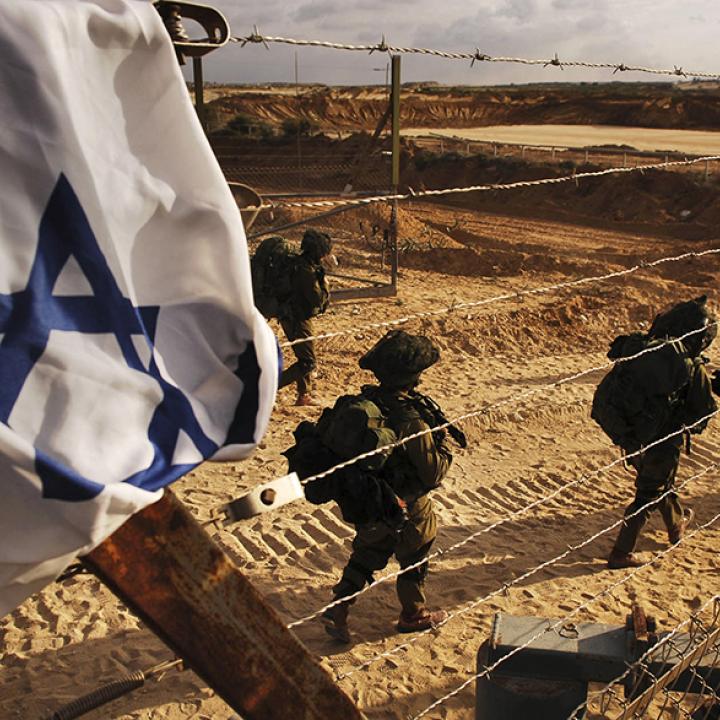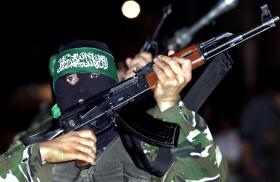
- Policy Analysis
- PolicyWatch 3501
Sword of Jerusalem vs. Guardian of the Walls: Gaza and the Next Lebanon War

The military particulars of the clash between Hamas and IDF doctrines reveal much common ground with potential future conflicts involving the other members of Iran’s “axis of resistance.”
Last month, the Hamas operation “Sword of Jerusalem” met the Israel Defense Forces (IDF) operation “Guardian of the Walls” in the fourth major conflict between the two parties since Israel disengaged from the Gaza Strip in 2005. This round pitched two very different military doctrines against each other. Following Iran’s art of war (and using more than a few Iranian-designed weapons), Hamas and Palestinian Islamic Jihad (PIJ) relied mostly on rocket and mortar fire against Israel’s populated areas, complemented by attempted attacks over- and underground, by air and sea, and in the cyber domain. For survivability, Hamas embedded its military assets and operations in the heart of Gaza’s densely populated areas, investing heavily in digging an underground network of military tunnels that it dubbed “Jihad City.”
By launching heavy, indiscriminate rocket fire and other attacks against Israeli civilians, Hamas sought to inflict losses, disrupt daily life, terrorize the population, and project power among Palestinian and regional audiences. And by conducting such operations from within its own population centers, the group sought to dissuade the IDF from striking its forces—while at the same time drawing Israeli fire onto Gazan civilians. This cynical doctrine is a win-win for Hamas because it decreases Israel’s operational leeway while also imposing political and reputational costs for collateral casualties. In that sense, the group’s choice and design of the battlefield dictated many of the operational moves long before the first rocket was launched.
Interestingly, Hamas leader Yahya al-Sinwar stated earlier this month that if Gaza “resistance” factions had precision-guided missiles, they would focus their attacks on military targets only. He also claimed that they were gradually moving their command posts out of residential towers and homes. Such statements may be music to international ears and perhaps to some in Gaza as well, but they are unlikely to entail any actual internal reckoning or tactical changes—after all, even with its current weapons, Hamas could avoid targeting population centers if it wanted to.
For its part, Israel’s military defensive efforts thwarted all enemy attacks except rocket fire and isolated antitank missile attacks. The Iron Dome system intercepted around 90 percent of rockets headed to populated areas and some explosive drone attacks as well. Missile defense, early warning, and generally responsible civilian conduct saved many lives. Of the more than 4,300 rockets and mortars launched at Israel, around 3,600 made it over the border, around 1,700 were intercepted, and around 180 fell in populated areas, causing casualties and substantial damage at dozens of sites and disrupting daily life.
On the offensive side, the IDF conducted intelligence-driven precision strikes on Hamas and PIJ military targets in Gaza, hitting command-and-control elements, rocket launchers/crews, antitank missile teams, naval attack assets, intelligence assets, cyber/electronic warfare elements, weapons development/production sites and experts, terrorist financial assets, and the sprawling military tunnel network that the IDF dubbed “the Metro.” According to some reports, the original plan was to draw hundreds of Hamas combatants into the tunnels with a real or fake IDF ground maneuver, then destroy them with a massive simultaneous strike while they were trapped underground. Yet early strikes on certain underground targets and an unconvincing feint greatly decreased the number of Hamas casualties in the phased tunnel strikes.
When Matthias Schmale, the Gaza director for the UN Relief and Works Agency (UNRWA), candidly acknowledged that the IDF’s strikes had been “precise and sophisticated,” Hamas threatened him sufficiently to make him flee the Strip. Indeed, considering that the IDF struck around 1,500 targets in one of the most densely populated areas on earth, the numbers of civilian casualties—tragic and regrettable as they are—reflect Israel’s real effort to minimize the loss of innocent lives while striking legitimate military targets.
On the perception front, IDF messaging had conflicting effects among different domestic, Palestinian, regional, and international audiences. For example, much of the wide Israeli media coverage concerning damage and casualties at home wound up emphasizing defensive shortcomings, enhancing the enemy’s sense of achievement, and only partly reverberating in international opinion as justifying Israel’s self-defense. Conversely, media operating under Hamas’s dictum in Gaza reflected the IDF’s achievement of hitting enemy forces hard, but naturally supported the Hamas ethos of an underdog’s sacrifice while portraying Israel as the party responsible for all of the human toll. In short, IDF messaging efforts seemed to unlearn many of the lessons gleaned from the 2008 and 2014 campaigns.
Realizing that casualty counts are a potent way to impose reputational costs on Israel, Gaza officials typically bundle together combatant and noncombatant statistics, animating the numbers with graphic visuals of dead or injured children and women. Such releases hit their emotional targets effectively, but they do not tell the full story. The IDF initially assessed that as many as 200 of those killed were militants (some of whose bodies may still be trapped in collapsed tunnels); Hamas recently stated that it lost about half that number. Moreover, some of the Palestinian civilian casualties were caused by the estimated 680 Hamas/PIJ rockets that fell within the Strip. In other cases, at least two buildings collapsed upon residents far from the impact point of Israeli strikes because tunnels carried the blasts beyond their precalculated safety distances. Multiple civilian casualties also occurred when Israel struck militant commanders who were hiding behind human shields.
Implications for IDF and “Axis” Strategy
From a long-term perspective, the latest conflict was just another link in a chain of confrontations between Israel and Iranian terrorist proxies, from the 2006 Lebanon war to the 2008, 2012, and 2014 Gaza conflicts. After each bout, all parties carry lessons and improvements into the next round even if they were not directly involved in the previous fight.
IDF chief of the general staff Lt. Gen. Aviv Kochavi reflected on this still-emerging operational environment in a speech delivered this January, emphasizing how “armies of terror” with tens of thousands of personnel, large fighting units, and standard military weapons are increasingly deploying in populated urban spaces. By openly aiming their fire primarily at Israeli civilians, these “armies” engage in wide-scale terrorism. Their most significant threat is their growing volume of ballistic missiles and rockets with heavier warheads and improved precision, though they also wield advanced cruise missiles and substantial electronic warfare and cyber capabilities. In the past decade, Kochavi noted, Hamas and Hezbollah have also built forces whose purpose is to raid into Israeli territory. Taken together, their military doctrine represents a clear, preplanned violation of international law.
In response to this doctrine, and in order to fulfill Israel’s imperative to protect its population in a morally legitimate manner, Kochavi argued that the IDF has to “widely expose [the enemy], widely strike it, and widely destroy it.” Operational intelligence and massive precision-strike capabilities are the IDF’s answers to enemy concealment and decentralization of its weapons. In his view, the IDF’s core values and international laws regarding armed conflict exist not just to protect the other side’s noncombatants, but also for the sake of helping the IDF protect Israeli civilians. Precise intelligence enables the IDF to strike military targets according to the principle of discrimination. And when such strikes are conducted on a massive scale, they are more effective at decreasing the threat to Israel’s population, in accordance with the principle of proportionality.
Minimizing collateral damage when striking an enemy military target is important, yet Kochavi also argued that this calculation needs to be weighed against potential damage prevented in Israel. In Lebanon, he said, Hezbollah’s efforts to decentralize and disperse its forces throughout the population have created an environment in which “every fifth house is a military target.” The same goes for Gaza and other fronts. Accordingly, Kochavi urged local civilians who knowingly live among military targets to leave as soon as tensions rise in order to minimize the danger they will face if conflict erupts.
On the home front, Kochavi reminded listeners that in wartime, many missiles will still hit their targets in Israel despite all IDF efforts to the contrary. Given the imperatives of international law and national values, Israel has no reasonable way to mitigate this threat other than its current doctrine outlined above.
Yet what are the IDF’s realistic alternatives if a wider war breaks out? Under heavy, sustained enemy fire, relying on defensive operations alone would quickly deplete Israel’s missile defense interceptors, leading to a steep rise in casualties and damage at home. Sooner rather than later, the IDF would need to use offensive means to degrade the enemy threat. Airstrikes alone cannot sufficiently suppress heavy enemy fire, making ground maneuvers and their much-higher casualty counts inevitable. In the end, the most effective way to decrease incoming fire into Israel is to lessen the launching days—in other words, to seek the shortest conflict through high-intensity, simultaneous operations instead of phased efforts.
As most Western militaries that share the IDF’s values and legal adherence know too well, the doctrine described by Kochavi is currently the least bad of several bad options. This doctrine will no doubt be tested again, not just in Gaza, but also in Lebanon, where Hezbollah’s arsenal is ten times larger than Hamas’s and its fighting forces are much more powerful. Sadly, the Gaza conflict may have been just a trailer for the full disaster film awaiting the parties in Lebanon. For example, Gaza militants launched around 400 rockets per day at Israel in this round, but Hezbollah could sustain five to ten times that pace using heavier, more accurate weapons. At the same time, the IDF is capable of conducting at least a dozen times more daily strikes than its Gaza tally of around 150 strikes per day, perhaps hitting thousands of targets daily in a Lebanon war. These ballpark strike numbers could result in thousands of fatalities, especially since Lebanon’s size and the expected intensity of conflict would make it difficult for the IDF to practice the same collateral mitigating measures it used so widely in Gaza.
Rather than avoid such a cataclysm, Iran’s axis of resistance often seems bent on facilitating it. According to Ibrahim al-Amin, a confidant of Hezbollah leader Hassan Nasrallah, officers from the Lebanese militia shared an operations center in Beirut with their Hamas counterparts during last month’s conflict, helping them coordinate their actions, providing them with intelligence support, and monitoring enemy movements. Iranian Qods Force commander Esmail Qaani himself visited this center twice during the eleven days of fighting. And after the ceasefire was reached, Hezbollah, Iran, and Yemen’s Houthis joined Hamas and PIJ in threatening that the next “transgression” in Jerusalem would lead to a wider regional war against Israel (e.g., Nasrallah offered this message in a June 8 speech).
Because such belligerent rhetoric has sometimes become a self-fulfilling prophecy for “resistance” groups, and because Gaza is still at risk of re-escalating, one cannot prudently exclude additional conflicts erupting in the Strip, Lebanon, or elsewhere. To prevent these conflicts and their attendant human devastation, all parties will need to address the fact that intentional upstream preparation of densely populated urban battlefields has become the main strategy practiced by Iran and its proxies. When the rockets start flying, it will be too late.
Brig. Gen. Assaf Orion (Res.) is the Rueven International Fellow with The Washington Institute and former head of the Strategic Division in the IDF General Staff’s Planning Directorate.



